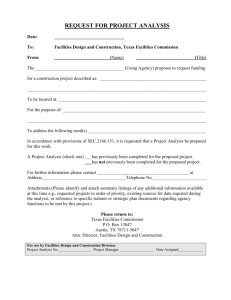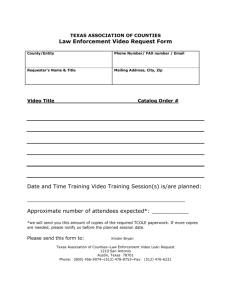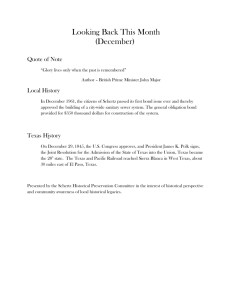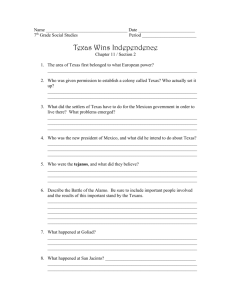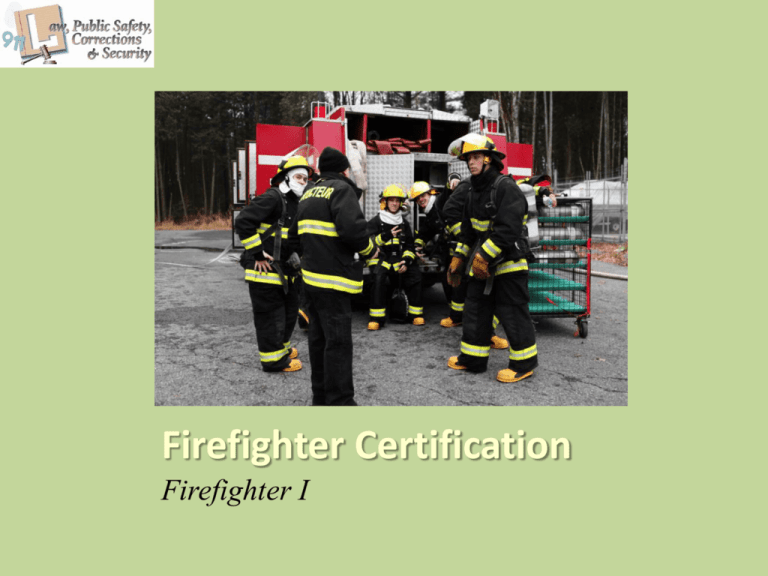
Firefighter Certification
Firefighter I
Copyright and Terms of Service
Copyright © Texas Education Agency, 2011. These materials are copyrighted © and trademarked
™ as the property of the Texas Education Agency (TEA) and may not be reproduced without the
express written permission of TEA, except under the following conditions:
1) Texas public school districts, charter schools, and Education Service Centers may reproduce
and use copies of the Materials and Related Materials for the districts’ and schools’
educational use without obtaining permission from TEA.
2) Residents of the state of Texas may reproduce and use copies of the Materials and Related
Materials for individual personal use only, without obtaining written permission of TEA.
3) Any portion reproduced must be reproduced in its entirety and remain unedited, unaltered
and unchanged in any way.
4) No monetary charge can be made for the reproduced materials or any document containing
them; however, a reasonable charge to cover only the cost of reproduction and distribution
may be charged.
Private entities or persons located in Texas that are not Texas public school districts, Texas
Education Service Centers, or Texas charter schools or any entity, whether public or private,
educational or non-educational, located outside the state of Texas MUST obtain written approval
from TEA and will be required to enter into a license agreement that may involve the payment of
a licensing fee or a royalty.
Contact TEA Copyrights with any questions you may have.
Copyright © Texas Education Agency 2013. All rights reserved.
Images and other multimedia content used with permission.
2
The Basic Steps
• The basic steps to becoming a licensed firefighter
in Texas (TCFP, 2014)
–
–
–
–
–
Finish a basic firefighter training program
Show that you can perform basic firefighting skills
Pass the state certification test
Finish your emergency-medical-responder training
Have your fingerprints taken and pass a criminal
history background check
– Apply for your certification
– Gain employment (or volunteer) within the fire service
Copyright © Texas Education Agency 2013. All rights reserved.
Images and other multimedia content used with permission.
3
Basic Firefighter
Training Programs
• A “basic structure-fire-suppression-training
program” is a school, course, or academy that
teaches everything in the commission’s
curriculum
• Texas requires a lot of training for its paid
firefighters
• The Texas basic curriculum includes 468 hours
of training
Copyright © Texas Education Agency 2013. All rights reserved.
Images and other multimedia content used with permission.
4
Basic Firefighter
Training Programs: Curriculum
• Firefighter I/II Curriculum Outline (TCFP,
2010)
– General introduction
– Fire department communications
– Foreground operations
– Rescue operations
– Prevention, preparedness, and maintenance
– Hazardous-materials awareness and operations
Copyright © Texas Education Agency 2013. All rights reserved.
Images and other multimedia content used with permission.
5
Basic Firefighter
Training Programs: Curriculum (continued)
• Hazmat Awareness Curriculum Outline (TCFP,
2010)
– General HAZMAT introduction
– Analyzing the incident hazmat
– Planning the response
– Implementing the planned response
– Evaluating progress
– Terminating the incident
Copyright © Texas Education Agency 2013. All rights reserved.
Images and other multimedia content used with permission.
6
Basic Firefighter
Training Programs: Curriculum (continued)
• Hazmat Materials Curriculum Outline (TCFP,
2010)
–
–
–
–
–
–
–
General hazmat introductions
Analyzing the incident
Planning the response
Implementing the planned response
Evaluating progress
Terminating the incident
Personal Protective Equipment (PPE) and product
control
Copyright © Texas Education Agency 2013. All rights reserved.
Images and other multimedia content used with permission.
7
Basic Firefighter
Training Programs: Curriculum (continued)
• US Department of Homeland Security Courses
(FEMA, 2013)
– Introduction to Incident Command System (ICS)
– ICS for single resources and initial action incidents
– National Incident Management System (NIMS)
– National Response Framework, an introduction
Copyright © Texas Education Agency 2013. All rights reserved.
Images and other multimedia content used with permission.
8
Qualifications for Texas Firefighters
• Qualifications for Texas Firefighters stated in the
Standards Manual for Fire Protection Personnel (Title
37, part 13, chapter 421, rule 421.3 in the Texas
Administrative Code)
– Complete a commission-approved course successfully and
achieve a passing score on the written and the performance
certification examinations
– Must be at least 18 years of age
– Must have at least a high school diploma (most
departments require some college)
– Have good manual dexterity with the ability to perform all
tasks related to the protection of life and property
Copyright © Texas Education Agency 2013. All rights reserved.
Images and other multimedia content used with permission.
9
Required Abilities for Texas Firefighters
• Communicate verbally, via telephone and radio equipment
• Lift, carry, drag, and balance the weight equivalent of the
average human
• Interpret in English, written, and oral instructions
• Work effectively in high-stress situations
• Work effectively in an environment with loud noises and
flashing lights
• Function through an entire work shift (which is usually 24
hours)
• Calculate weight and volume ratios
• Read and understand English-language manuals, including
chemical, medical, and technical terms, and road maps
Copyright © Texas Education Agency 2013. All rights reserved.
Images and other multimedia content used with permission.
10
Required Abilities for Texas Firefighters
(continued)
• Discern accurately street signs and address numbers
• Document in English all relevant information in a
prescribed format in light of legal ramifications
• Converse in English with coworkers and other
emergency response personnel
• Bend, stoop, and crawl on uneven surfaces
• Withstand varied environmental conditions such as
extreme heat, cold, and moisture
• Work in low or no light, confined spaces, elevated
heights and other dangerous environments
Copyright © Texas Education Agency 2013. All rights reserved.
Images and other multimedia content used with permission.
11
Various Levels of
Firefighting Certifications
• Structural firefighter (Basic, Intermediate,
Advanced, and Master)
– The following are needed to advance in the levels
of certification (for all of the “specialties” listed on
the next slide)
•
•
•
•
Amount of time with current certification in the field
Educational hours in the content/specialty area
Application submitted (with transcripts)
$85.00
Copyright © Texas Education Agency 2013. All rights reserved.
Images and other multimedia content used with permission.
12
Various Levels of
Firefighting Certifications (continued)
• Aircraft (Basic, Intermediate, Advanced, and Master)
• Marine (Basic, Intermediate, Advanced, and Master)
• Fire-Service Instructor (Basic, Intermediate, Advanced,
and Master)
• Fire Inspector
• Fire Investigator
• Driver Operator/Pumper
• Fire Officer I, II, III, IV
• HAZMAT (Tech and Incident Commander)
• Wildland
• Incident Safety Officer
Copyright © Texas Education Agency 2013. All rights reserved.
Images and other multimedia content used with permission.
13
NFPA 1500, Standard on Fire Department
Occupational Safety and Health Program
• This standard was developed to provide a
consensus standard for an occupational safety
and health program for the fire service
• The intent of this standard is to provide the
framework for a safety and health program for
a fire department or any type of organization
providing similar services
Copyright © Texas Education Agency 2013. All rights reserved.
Images and other multimedia content used with permission.
14
NFPA 1500, Standard on Fire Department
Occupational Safety and Health Program
(continued)
• The fire department shall actively attempt to
identify and limit or prevent the exposure of
members to infectious and contagious diseases
in the performance of their assigned duties
• The fire department shall operate an infection
control program that meets the requirements of
NFPA standards. When appropriate,
inoculations, vaccinations, and other treatment
shall be made available
Copyright © Texas Education Agency 2013. All rights reserved.
Images and other multimedia content used with permission.
15
NFPA 1500, Standard on Fire Department
Occupational Safety and Health Program
(continued)
• When fire department members routinely respond to
emergency medical incidents, the fire department should
consult with medical professionals and agencies on
measures to limit the exposure of members to infectious and
contagious diseases. This should include the provision and
maintenance of equipment to avoid or limit direct physical
contact with patients, when feasible
• Members who perform emergency medical care or
otherwise may be exposed to blood or other body fluids
shall be provided with emergency medical garments,
emergency medical face protection devices, and emergency
medical gloves that meet the applicable requirements of
NFPA standards
Copyright © Texas Education Agency 2013. All rights reserved.
Images and other multimedia content used with permission.
16
Training Facilities
• Several of the state's large fire departments run their own
fire academies
• These academies are typically open only to the departments’
recruits
• There are also public and private fire academies put on by
community colleges and private institutions throughout the
state
• Every fire department has its own hiring process. In general,
hiring processes include:
–
–
–
–
A civil-service test
A physical-ability test: Candidate Physical Ability Test (CPAT)
A series of interviews
A criminal background check
Copyright © Texas Education Agency 2013. All rights reserved.
Images and other multimedia content used with permission.
17
Training Facilities (continued)
• Some departments will not accept your
application unless you already have emergency
responder medical training, such as a
– National Registry of Emergency Medical
Technicians - Basic certificate (NREMT-B)
– National Registry of Emergency Medical
Technicians -Paramedic (NREMT-P) certificate
Copyright © Texas Education Agency 2013. All rights reserved.
Images and other multimedia content used with permission.
18
Training Facilities (continued)
• The competition for these jobs can be fierce.
Some of the state's larger departments have
several hundred applicants for each open position
(i.e. In 2012 the Dallas Fire Department had 1600
applicants for 60 positions)
• If you have your heart set on working at a specific
department, learn everything you can about the
department and keep an eye on its human
resources website. In general, these departments
only hire once a year, have prerequisites, and
clearly state their hiring process
Copyright © Texas Education Agency 2013. All rights reserved.
Images and other multimedia content used with permission.
19
Basic Fire Suppression Written Exam
• You must pass the commission's basic structure-fire
suppression examination, which contains a written
section and a performance skills section
• In order to pass the exam you must receive a grade of at
least 70 percent on the written portion and a pass on the
performance skills test
• No one can be a firefighter in Texas without this
certificate
• In order to schedule the exam you must contact the
Texas Commission on Fire Protection, and they will
mail a packet with a study guide and the examination
schedule
Copyright © Texas Education Agency 2013. All rights reserved.
Images and other multimedia content used with permission.
20
Emergency Medical Technician
(EMT) Requirement
• All firefighters in Texas must show proof that they have
completed the Department of State Health Service's (DSHS)
emergency care attendant (ECA) or the American Red Cross
Emergency Responder training
• Most community colleges, fire departments, and other forprofit sources provide this training
• The Department of State Health Service has a list of
providers
• The most common form of required certification is a
NREMT-B or NREMT-P
– Those departments requiring their firefighters to ride on a
Medical Intensive Care Unit (MICU) and to provide Advanced
Cardiovascular Life Support (ACLS) and advanced medical care
need the higher NREMT-P designation
Copyright © Texas Education Agency 2013. All rights reserved.
Images and other multimedia content used with permission.
21
Governing Body for Credentials,
Curriculum, and Accreditation
• Texas Commission of Fire Protection
– Phone number: (512) 936-3838
– Fax number: (512) 936-3808
– Address: Texas Commission on Fire Protection,
PO Box 2286, Austin, TX 78768-2286
– Physical Address: 1701 N. Congress, Suite 105,
Austin, TX 78701
Copyright © Texas Education Agency 2013. All rights reserved.
Images and other multimedia content used with permission.
22
Resources
• Texas Commission on Fire Protection http://www.tcfp.texas.gov/
• Certification Curriculum Manual, Basic Fire Suppression Curriculum,
NFPA 1001, 2008 Edition
http://www.tcfp.texas.gov/manuals/curriculum_manual/chapter_1.pdf
• National Fire Protection Association (NFPA) Standards Manual for Fire
Protection
• NFPA: Standard for Fire Fighter Professional Qualifications
http://www.nfpa.org/codes-and-standards/document-informationpages?mode=code&code=1001&DocNum=1001
• NFPA 1500: Standard on Fire Department Occupational Safety and Health
Program http://www.nfpa.org/codes-and-standards/document-informationpages?mode=code&code=1500
• Federal Emergency Management Agency (FEMA) http://training.fema.gov/
• 0135151112, Essentials of Firefighting (5th Edition), International Fire
Service Training Association (IFSTA)
Copyright © Texas Education Agency 2013. All rights reserved.
Images and other multimedia content used with permission.
23




